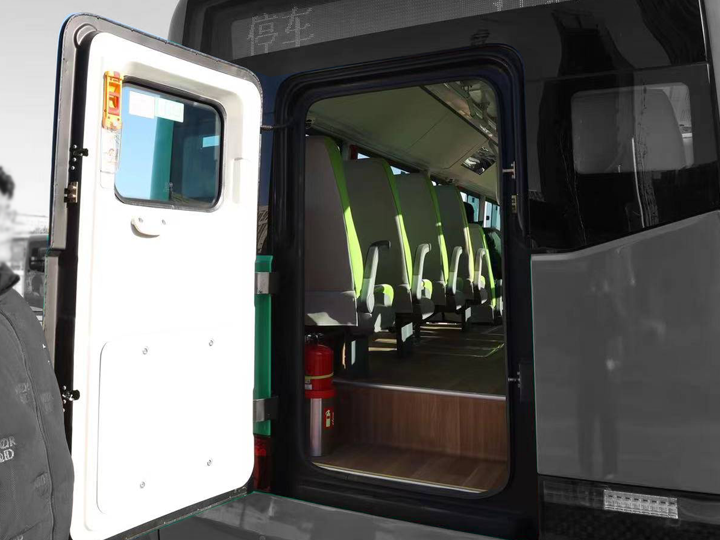客车安全门是客车上的紧急出口,用于在紧急情况下帮助乘客快速逃生。当客车遇到紧急情况,如着火等,而车门无法打开时,安全门成为乘客逃生的重要通道。使用客车安全门的关键在于掌握正确的开启方法。在遇到紧急情况时,乘客应首先找到安全门的放气阀,打开阀盖,顺时针旋转红色旋钮,等待5-10秒钟后,推开安全门逃生。如果逃生时打开了应急阀但推不开车门,应先检查车锁是否打开,再开启应急阀。此外,先行逃出的乘客可以通过安全门帮助车上的其他乘客逃生,因为车外也有安全门应急阀装置,使用方法与车内相同,只是拉开车门需要比从内推开车门的力量稍大一些。
客车安全门的类型多样,包括折叠式、外摆式、内摆式等,主要根据客车的长度、乘客上下车的频率以及设计要求进行选择。设计乘客门时,需要考虑其启闭的灵活性、平稳性、关闭速度、锁止功能、由驾驶员或售票员单独或共同控制的能力,以及在可能夹住乘客的门边缘安装橡胶密封条等安全措施。此外,客车乘客门还需满足技术规范,确保足够的刚度、不易变形、行车时不振响,并安装门锁(除非是城市客车)。制造工艺也应考虑易于冲压并便于安装。
总之,客车安全门的设计和使用都是为了在紧急情况下提供乘客逃生的通道,其正确使用对于保障乘客安全至关重要。
Bus safety doors are emergency exits on buses used to assist passengers in quickly escaping in emergency situations. When a bus encounters an emergency situation, such as a fire, and the doors cannot be opened, the safety door becomes an important escape route for passengers. The key to using bus safety doors is to master the correct opening method. In case of emergency, passengers should first locate the vent valve of the safety door, open the valve cover, turn the red knob clockwise, wait for 5-10 seconds, and then push open the safety door to escape. If the emergency valve is opened during escape but the car door cannot be pushed open, the car lock should be checked first before opening the emergency valve. In addition, passengers who escape first can help other passengers in the car escape through the safety door, as there is also an emergency valve device for the safety door outside the car. The usage method is the same as inside the car, except that opening the car door requires slightly more force than pushing it open from inside.
There are various types of bus safety doors, including folding, outward swinging, inward swinging, etc., which are mainly selected based on the length of the bus, the frequency of passengers getting on and off the bus, and design requirements. When designing passenger doors, it is necessary to consider their flexibility, smoothness, closing speed, locking function, ability to be controlled individually or jointly by the driver or ticket seller, as well as safety measures such as installing rubber seals at the edges of doors that may clamp passengers. In addition, passenger doors of buses must meet technical specifications to ensure sufficient rigidity, resistance to deformation, and no vibration during driving, and be equipped with door locks (except for city buses). The manufacturing process should also consider ease of stamping and installation.
In short, the design and use of bus safety doors are aimed at providing passengers with an escape route in emergency situations, and their correct use is crucial for ensuring passenger safety.
安全门
